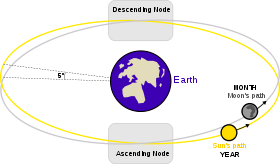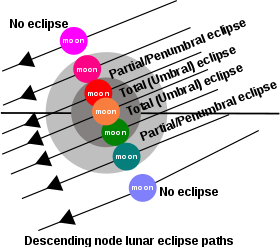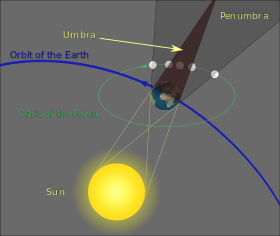
Lunar eclipse
About this schools Wikipedia selection
Arranging a Wikipedia selection for schools in the developing world without internet was an initiative by SOS Children. All children available for child sponsorship from SOS Children are looked after in a family home by the charity. Read more...


A lunar eclipse occurs whenever the Moon passes through some portion of the Earth's shadow. This can occur only when the Sun, Earth, and Moon are aligned exactly, or very closely so, with the Earth in the middle. Hence, there is always a full moon the night of a lunar eclipse. The type and length of an eclipse depend upon the Moon's location relative to its orbital nodes.
The last lunar eclipse was total, and occurred on February 21, 2008. The next eclipse--a partial one--occurs on August 16, 2008. The next total lunar eclipse occurs on December 21, 2010.
Types of lunar eclipses
The shadow of the Earth can be divided into two distinctive parts: the umbra and penumbra. Within the umbra, there is no direct solar radiation. However, as a result of the Sun's large angular size, solar illumination is only partially blocked in the outer portion of the Earth's shadow, which is given the name penumbra.
A penumbral eclipse occurs when the Moon passes through the Earth's penumbra. The penumbra does not cause any noticeable darkening of the Moon's surface, though some may argue it turns a little yellow. A special type of penumbral eclipse is a total penumbral eclipse, during which the Moon lies exclusively within the Earth's penumbra. Total penumbral eclipses are rare, and when these occur, that portion of the Moon which is closest to the umbra can appear somewhat darker than the rest of the Moon.
A partial lunar eclipse occurs when only a portion of the Moon enters the umbra. When the Moon travels completely into the Earth's umbra, one observes a total lunar eclipse. The Moon's speed through the shadow is about one kilometer per second (2,300 mph), and totality may last up to nearly 107 minutes. Nevertheless, the total time between the Moon's first and last contact with the shadow is much longer, and could last up to 3.8 hours. The relative distance of the Moon from the Earth at the time of an eclipse can affect the eclipse's duration. In particular, when the Moon is near its apogee, the farthest point from the Earth in its orbit, its orbital speed is the slowest. The diameter of the umbra does not decrease much with distance. Thus, a totally-eclipsed Moon occurring near apogee will lengthen the duration of totality.
A selenelion or selenehelion occurs when both the Sun and the eclipsed Moon can be observed at the same time. This can only happen just before sunset or just after sunrise, and both bodies will appear just above the horizon at nearly opposite points in the sky. This arrangement has led to the phenomenon being referred to as a horizontal eclipse. It happens during every lunar eclipse at all those places on the Earth where it is sunrise or sunset at the time. Indeed, the reddened light that reaches the Moon comes from all the simultaneous sunrises and sunsets on the Earth. Although the Moon is in the Earth's geometrical shadow, the Sun and the eclipsed Moon can appear in the sky at the same time because the refraction of light through the Earth's atmosphere causes objects near the horizon to appear higher in the sky than their true geometric position.
The Moon does not completely disappear as it passes through the umbra because of the refraction of sunlight by the Earth's atmosphere into the shadow cone; if the Earth had no atmosphere, the Moon would be completely dark during an eclipse. The red colouring arises because sunlight reaching the Moon must pass through a long and dense layer of the Earth's atmosphere, where it is scattered. Shorter wavelengths are more likely to be scattered by the small particles, and so by the time the light has passed through the atmosphere, the longer wavelengths dominate. This resulting light we perceive as red. This is the same effect that causes sunsets and sunrises to turn the sky a reddish colour; an alternative way of considering the problem is to realise that, as viewed from the Moon, the Sun would appear to be setting (or rising) behind the Earth.
The amount of refracted light depends on the amount of dust or clouds in the atmosphere; this also controls how much light is scattered. In general, the dustier the atmosphere, the more that other wavelengths of light will be removed (compared to red light), leaving the resulting light a deeper red colour. This causes the resulting coppery-red hue of the Moon to vary from one eclipse to the next. Volcanoes are notable for expelling large quantities of dust into the atmosphere, and a large eruption shortly before an eclipse can have a large effect on the resulting colour.
Danjon scale
The following scale (the Danjon scale) was devised by André Danjon for rating the overall darkness of lunar eclipses:
- L=0: Very dark eclipse. Moon almost invisible, especially at mid-totality.
- L=1: Dark Eclipse, gray or brownish in colouration. Details distinguishable only with difficulty.
- L=2: Deep red or rust-colored eclipse. Very dark central shadow, while outer edge of umbra is relatively bright.
- L=3: Brick-red eclipse. Umbral shadow usually has a bright or yellow rim.
- L=4: Very bright copper-red or orange eclipse. Umbral shadow has a bluish, very bright rim.
Eclipse cycles
Every year there are usually at least two partial lunar eclipses, although total eclipses are significantly less common. If one knows the date and time of an eclipse, it is possible to predict the occurrence of other eclipses using an eclipse cycle like the Saros cycle. Unlike a solar eclipse, which can only be viewed from a certain relatively small area of the world, a lunar eclipse may be viewed from anywhere on the night side of the Earth.
Recent lunar eclipse events
- 3 March 2007 lunar eclipse - The first total lunar eclipse of 2007 occurred on 03 March 2007 and was partially visible from the Americas, Asia and Australia. The complete event was visible throughout Africa and Europe. The event lasted 01h:15m, began at 20:16 UTC, and reached totality at 22:43 UTC.
- August 2007 lunar eclipse - 28 August 2007 saw the second total lunar eclipse of the year. The initial stage began at 07:52 UTC, and reached totality at 09:52 UTC. This eclipse was viewable form Eastern Asia, Australia and New Zealand the Pacific, and the Americas.
- February 2008 lunar eclipse - The only total lunar eclipse of 2008 occurred on 21 February 2008, beginning at 01:43 UTC, visible from Europe, the Americas, and Africa.
- The next partial eclipse of the Moon will occur on 16 August 2008.
- The next total eclipse of the Moon will occur on 21 December 2010.


